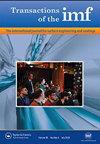加速Cr(III)电解液中厚铬沉积的耐蚀性和耐磨性
IF 1.5
4区 材料科学
Q4 ELECTROCHEMISTRY
Transactions of The Institute of Metal Finishing
Pub Date : 1998-01-01
DOI:10.1080/00202967.1998.11871216
引用次数: 27
摘要
对铬(III)电解质的研究表明,这种电解质的沉积速率低得令人难以接受是由于μ-羟基桥接低聚物的形成,这些低聚物吸附并毒害了晶体生长部位。甲醇和甲酸已被证明在延缓低聚物形成方面特别有效。开发了一种环境可接受的三价铬电解液,优化了甲醇和甲酸的添加量。非甲醇浴中的羟基桥接低聚物产生了良好的分散,加上高残余应力,形成了异常坚硬、脆性高磨损率的涂层。当液中甲醇含量为20%时,磨损率最低,其磨损程度略低于传统的六价铬镀。腐蚀始于涂层的裂纹,在低甲醇浓度的电解液中,涂层的高残余应力水平会产生宽透厚的裂纹和高腐蚀。本文章由计算机程序翻译,如有差异,请以英文原文为准。
Corrosion and Wear Resistance of Thick Chromium Deposits from Accelerated Cr(III) Electrolytes
SummaryA study of a number of chromium(III) electrolytes has indicated that the unacceptably low deposition rate from such electrolytes is due to the formation of μ-hydroxo bridged oligomers, which adsorb and poison the crystal growth sites. Methanol and formic acid have been shown to be particularly effective in delaying oligomer formation. An environmentally acceptable trivalent chromium electrolyte with optimized additions of methanol and formic acid has been developed. The hydroxo-bridged oligomers in the nonmethanolic bath produce a fine dispersion and this together with a high residual stress gives an exceptionally hard, brittle coating with a high wear rate. A minimum in wear rate is obtained at 20% methanol in the bath, at which the wear is slightly less than that of conventional hexavalent chromium plating. Corrosion initiates at cracks in the coating and their high residual stress levels at low methanol concentrations, in the electrolyte, generate wide through-thickness cracks and high corrosion...
求助全文
通过发布文献求助,成功后即可免费获取论文全文。
去求助
来源期刊

Transactions of The Institute of Metal Finishing
工程技术-材料科学:膜
CiteScore
3.40
自引率
10.50%
发文量
62
审稿时长
3 months
期刊介绍:
Transactions of the Institute of Metal Finishing provides international peer-reviewed coverage of all aspects of surface finishing and surface engineering, from fundamental research to in-service applications. The coverage is principally concerned with the application of surface engineering and coating technologies to enhance the properties of engineering components and assemblies. These techniques include electroplating and electroless plating and their pre- and post-treatments, thus embracing all cleaning pickling and chemical conversion processes, and also complementary processes such as anodising. Increasingly, other processes are becoming important particularly regarding surface profile, texture, opacity, contact integrity, etc.
 求助内容:
求助内容: 应助结果提醒方式:
应助结果提醒方式:


